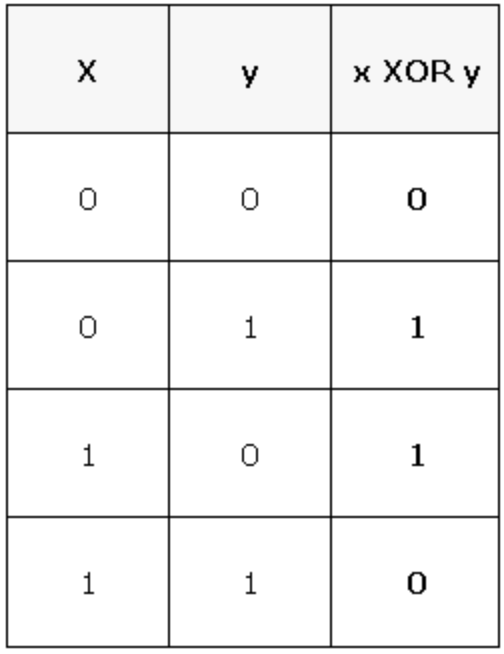
Open-Source Internship opportunity by OpenGenus for programmers. Apply now.
Reading time: 10 minutes
In this post I am going to "explore the bitwise algorithm to find the only number occuring odd number of times in a given set of numbers". I am handling the task using the bitwise operator XOR and I have chosen to implement the algorithm in Python3 since I am quite comfortable with the language.
A bitwise operator operates on binary numbers and considers one bit at a time. There are many bitwise operators like the AND, OR, NOT, NOR operators but for the given problem, I am considering the XOR or the Exclusive OR operator.
The XOR operator gives an output 0 when a number is operated with itself (e.g. 5 XOR 5 = 0). Moreover, when a number is operated with 0, the operator gives the number itself as the output (e.g. 5 XOR 0 = 5). Furthermore, the XOR operator is commutative (i.e. x XOR y = y XOR x) and associative (i.e. x XOR (y XOR z) = (x XOR y) XOR z). The truth table for an XOR gate is as shown below.

The basic idea is that if one initialises a variable as 0 and applies the XOR operator to the variable with each element of an array of numbers, at the end the variable will store the number which has been repeated odd number of times. This is simply because an even frequency will nullify the value stored in the variable. The process will be clearer with the aid of the pseudocode and hand simulation.
Pseudocode
Pseudocode:
Considering an array of numbers, "array", and each element of the array, "element";
1. Set result = 0
2. Repeat step 3 while element is in array
3. Set result = result XOR element
4. Return result
5. Exit
Hand Simulation
Considering the array = [2, 3, 2, 1, 3, 2, 1];
Clearly, intuition suggests that the number repeated odd number of times is 2. Let us check if the above pseudocode works or not.
- According to step 1, we set
result= 0. - Since
elementis inarray, we enter into the loop. In the following table I compare the values of the variableresultat every pass of the loop:
| Pass | Element in the Array | 'result' |
|---|---|---|
| 0 | - | 0 = 0000 |
| 1 | 2 | 0 XOR 2 = 0000 XOR 0010 = 0010 = 2 |
| 2 | 3 | 2 XOR 3 = 0010 XOR 0011 = 0001 = 1 |
| 3 | 2 | 1 XOR 2 = 0001 XOR 0010 = 0011 = 3 |
| 4 | 1 | 3 XOR 1 = 0011 XOR 0001 = 0010 = 2 |
| 5 | 3 | 2 XOR 3 = 0010 XOR 0011 = 0001 = 1 |
| 6 | 2 | 1 XOR 2 = 0001 XOR 0010 = 0011 = 3 |
| 7 | 1 | 3 XOR 1 = 0011 XOR 0001 = 0010 = 2 |
- According to step 4,
resultreturns the value 2.
The final value stored in the variableresultis 2 which matches with the intuition.
Complexity
- Time complexity:
Θ(n) - Space complexity:
Θ(1)
Implementation
Python3
array = [2, 3, 2, 1, 3, 2, 1]
result = 0
for element in array:
result = result ^ element
print(result)
